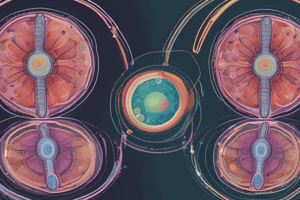Podcast
Questions and Answers
What is the process by which the cytoplasm of the parent cell is divided between the two daughter cells?
What is the process by which the cytoplasm of the parent cell is divided between the two daughter cells?
- Meiosis
- Cellular Organization
- Mitosis
- Cytokinesis (correct)
Which type of cell division ensures genetic stability and maintains tissues and organs?
Which type of cell division ensures genetic stability and maintains tissues and organs?
- Cytokinesis
- Mitosis (correct)
- Meiosis
- Cell Cycle Regulation
What proteins act as switches to regulate cell division?
What proteins act as switches to regulate cell division?
- Cytokines
- Cyclins (correct)
- Ribosomes
- Histones
Which process generates genetic variation essential for sexual reproduction?
Which process generates genetic variation essential for sexual reproduction?
What ensures that each daughter cell receives a complete set of organelles needed for its specific functions?
What ensures that each daughter cell receives a complete set of organelles needed for its specific functions?
Which type of cell division involves two rounds of division, producing four haploid cells?
Which type of cell division involves two rounds of division, producing four haploid cells?
What is the primary role of mitosis in cell division?
What is the primary role of mitosis in cell division?
Which type of cell division produces sperm and egg cells?
Which type of cell division produces sperm and egg cells?
During which phase of the cell cycle does DNA replication occur?
During which phase of the cell cycle does DNA replication occur?
What is the function of cytokinesis in cell division?
What is the function of cytokinesis in cell division?
Which phase of the cell cycle involves the actual division of the cell?
Which phase of the cell cycle involves the actual division of the cell?
What is the main purpose of meiosis in sexually reproducing organisms?
What is the main purpose of meiosis in sexually reproducing organisms?
Study Notes
Cell Division: Unraveling Mitosis, Meiosis, and More
Cell division is a fundamental process in life, allowing cells to reproduce and maintain the balance of tissues and organs in our bodies. This complex process can be broken down into two primary types, each playing a distinct role in biological functions.
Mitosis and Meiosis
Mitosis is the most common type of cell division, where a single cell divides into two identical daughter cells, each containing a complete set of chromosomes. This process ensures that the body's cells remain genetically stable and capable of performing their specific functions. Meiosis, on the other hand, is a specialized form of cell division that produces haploid cells, or gametes, such as sperm and egg cells. Meiosis results in genetic variation, which is essential for the survival of sexually reproducing organisms.
The Cell Cycle
The cell cycle consists of four phases: interphase, M phase (mitosis phase), prophase, prometaphase, metaphase, anaphase, and telophase. Interphase is the longest phase, during which the cell grows and replicates its DNA. M phase is the stage when the actual cell division occurs. In addition to these phases, cells spend significant time in the G1, S, and G2 phases during interphase.
Chromosome Structure and Cytokinesis
Chromosomes are long, double-stranded DNA molecules containing genes and other genetic information. During cell division, chromosomes condense and become visible as discrete entities. Cytokinesis is the process by which the cytoplasm of the parent cell is divided between the two daughter cells, establishing cellular boundaries.
Cell Cycle Regulation
Cells control their division by communicating with each other through chemical signals from special proteins called cyclins. These signals act like switches to tell cells when to start dividing and later when to stop dividing. It is crucial for cells to divide so that organisms can grow, their cuts can heal, and cells can replace damaged or lost tissue.
Cellular Organization and Function
The division of cells does not affect organelles that are not duplicated during the process, such as the Golgi apparatus, which breaks down and reassembles in each new daughter cell. This means that each daughter cell receives a complete set of organelles needed for its specific functions.
Mitosis and Meiosis in Action
In healthy cells, mitosis ensures that cells remain genetically identical and perform their specific functions within the body. Meiosis, on the other hand, generates genetic variation, which is essential for sexual reproduction and the survival of species. Meiosis involves two rounds of cell division, producing four haploid cells, each containing half the number of chromosomes as the original parent cell.
Cell division is a dynamic and complex process that allows organisms to grow and maintain their tissues and organs. The two primary types of cell division—mitosis and meiosis—ensure genetic stability and genetic variation, respectively, playing critical roles in the survival and evolution of life on Earth.
Studying That Suits You
Use AI to generate personalized quizzes and flashcards to suit your learning preferences.
Description
Explore the intricate process of cell division through mitosis and meiosis, essential for reproduction and genetic stability in organisms. Learn about the cell cycle phases, chromosome structure, cytokinesis, and cell cycle regulation mechanisms.



